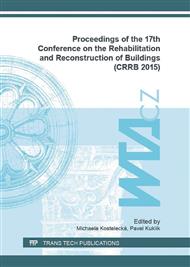[1]
J. Trejbal et al., The effect of glass fiber reinforcement on flexural strength of lime-based mortars, in. Proceedings of the 53rd Conference on Experimental stress analysis, EAN 2015, Český Krumlov, pp.450-453.
Google Scholar
[2]
J. Trejbal et al., Modification of surface of reinforced glass fibres for the purpose of used in reinforcement of mortars, in.: Proceedings of the 3rd Conference on Nanomateriály a nanotechnologie ve stavebnictví, NANS 2014, Praha, pp.144-151.
Google Scholar
[3]
Bartoš et al., Possibilities of modification PET microfibres' surface layer to improve their cohesion with cement matrix, in.: Proceedings of the 3rd Conference on Nanomateriály a nanotechnologie ve stavebnictví, NANS 2014, Praha, pp.12-19.
Google Scholar
[4]
J. Antoš, V. Nežerka, P. Tesárek, Using digital image correlation for investigation of low-strain fiber concrete cracking, in.: Proceedings of the 53rd Conferencence on Experimental Stress Analysis, EAN 2015, Český Krumlov, pp.1-5.
Google Scholar
[5]
V. Cech et al., Enhanced interfacial adhesion of glass fibers by tetravinylsilane plasma modification, Composites: Part A. 58 (2014) 84-89.
DOI: 10.1016/j.compositesa.2013.12.003
Google Scholar
[6]
A.M. López-Buendía et al., Surface treated polypropylene (PP) fibres for reinforced concrete, Cement and Concrete Research. 54 (2013) 29-35.
DOI: 10.1016/j.cemconres.2013.08.004
Google Scholar
[7]
S.E. Elsaka, Influence of chemical surface treatments on adhesion of fiber posts to composite resin core materials, Dental materials. 29 (2013) 550-558.
DOI: 10.1016/j.dental.2013.03.004
Google Scholar
[8]
V. Cech et al., Plasma surface treatment and modification of glass fibers, Composites: Part A. 33 (2002) 1367-1372.
Google Scholar
[9]
S. Li et al., Surface modification of aramid fibers via ammonia-plasma treatment, Journal of Applied Polymer Science. 131 (2014) 2-6.
Google Scholar
[10]
Y. Yuan, Contact Angle and Wetting Properties, Surface Science Techniques, Springer Berlin Heidelberg, (2013).
Google Scholar
[11]
J. Trejbal, L. Kopecký, Š. Potocký, Direct optical methods of contact angle meteing on the micro fibers, in.: Proceedings of the 4th Conference on Nanomateriály a nanotechnologie ve stavebnictví, NANS 2015, Praha, pp.90-95.
Google Scholar


